Island Font Concept Proposal (島:字型提案概念展) features 6 original Chinese font types created by five Taiwanese designers. The exhibition is organized by JustFont, a design team that runs educational programs and publications about the study and design of Chinese characters. In 2015, the team released the world’s first crowd-sourced Chinese font, jf Jinxuan (jf金萱), with the help of over 9,000 sponsors. The type is inspired by Jinxuan (金萱), a popular Taiwanese tea known for its elegant aroma. The bold version of this font, Jinxuan Full Sugar (金萱全糖), is characterized by wide strokes with pointy ends arranged in an orderly square format. The exhibition also features Shih Bo-han’s (施博瀚) Cream (凝書體), which won the Golden Pin Design Award last year. Cream embodies the qualities swiftness, purity, gentleness and clarity; it is structured with a strong core that holds together a flow of contours ranging in thickness. Chen Kuan-ying’s (陳冠穎) Nichi Nichi Round (日日新) takes inspiration from the style of advertisement letters seen during the Japanese colonial period. Alen Yang’s (楊宗烈) Tears (淚體) is a type font imbued with as much potential for passion as its title suggests; every stroke is shaped like a droplet that is ready to make a splash.
■ King Car Cultural and Art Center (金車文藝中心承德館), 4F, 131, Chengde Rd Sec 3, Taipei City (台北市承德路3段131號4樓), tel: (02) 2595-9650. Open Tuesdays to Sundays from 11am to 6pm
■ Until May 6
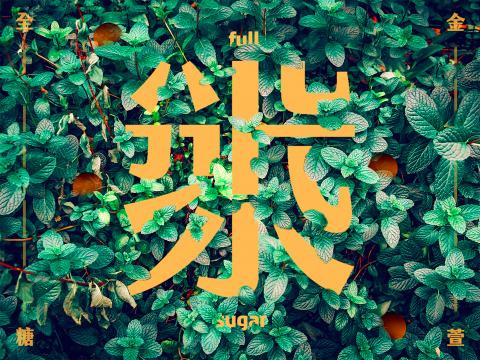
Photo courtesy of JustFont
Curated by the Technical University of Munich and the German Institute for Foreign Cultural Relations, 100 Years German Werkbund is a touring design exhibition that celebrates the legacy of German Werkbund, one of the 20th century’s most influential design alliances. The group was founded in Munich by a group of artists, architects and business firms in 1907 as an effort to integrate the knowledge of traditional craftsmanship, art and mass industrial production. The Werkbund played a leading role in “major design experiments for the new world characterized by technology, international quality and mobility,” according to the exhibition’s preface. To this day, their imprint on modern design culture is still seen in standard methodologies of industrial design and corporate identity design. The show features over 1,000 artifacts by members of the Werbund including posters, models, furniture, designed products, diagrams and photos. Some of the highlights include Peter Behrens’s Electric Tea and Water Kettles, a set of modern kettles made of nickel-plated brass and rattan; Hermann Gretsch’s ‘1382’ Coffee and Tea Service (1931), a set of unadorned, white porcelain ceramics that accentuate basic forms; and the 1914 Werkbund exhibition poster designed by Fritz Hellmut Ehmcke.
■ National Taiwan Craft Research and Development Institute Taipei Branch (臺北當代工藝設計分館), 41, Nanhai Road, Taipei City (台北市南海路41號), tel: (02) 2388-7066 and (02) 2388-9969. Open Tuesdays to Sundays from 9:30am to 5:30pm
■ Until April 8
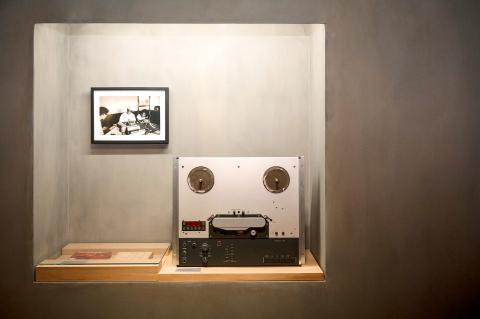
Photo courtesy of Taiwan Music Institute
The annual Taipei art festival, Very Fun Park (粉樂町), organized by Fubon Art Foundation continues its efforts to integrate art into city life by presenting works in a number of indoor and outdoor spaces around town. Focusing on the theme “city expressions,” the festival includes sculptures and site-specific installations by 10 international and local artists at Taipei New Horizon (台北文創), Fubon A25 Building (富邦A25), Four Four South Village (四四南村) and the 2.3 kilometer-long Xinyi Commerical District pedestrian bridge (信義商圈天橋). Hsu Min-sheng’s (徐暋盛) Take A Stroll (悠悠漫步) uses a variety of bamboo weaving techniques that reflect on the memories of military dependent villages built in the 50’s and 60’s as housing units for the Republic of China soldiers and their families. American artist Magda Sayeg’s Untitled covers a segment of the Xinyi pedestrian bridge with colorful yarn; the gentle weaves stand in stark contrast with the cold, concrete and metal structures of the industrial bridge. Hsu Ting-jui’s (許廷瑞) Origami Chameleon (折紙系列—變色龍) consists of three outdoor sculptures made from large stainless steel sheets folded into the shape of chameleons. Chiu Chao-tsai’s (邱昭財) The Singing Chair (聽椅子唱歌) is a group of chairs that play relaxing melodies upon being sit on.
■ Taipei New Horizon (台北文創), Fubon A25 Building (富邦25), Four Four South Village (四四南村) and Xinyi Commercial District Pedestrian Bridge (信義商圈天橋). For further details, contact Fubon Art Foundation at tel: (02) 2754-6655. Opening hours differ by venue.
■ Until May 13
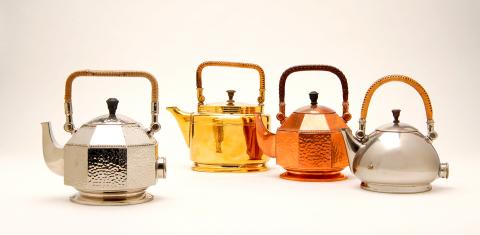
Photo courtesy of Die Neue Sammlung — The International Design Museum Munich
Liang Gallery is currently showing Action Through Inaction, a solo exhibition by Taiwanese artist Chou Tai-chun (周代焌). Chou creates paintings and installations that often allude to science fiction themes intermixed with references to the physical world we live in. In this exhibition, the artist continues to explore the relationship between humans and the environment through a series of paintings that “visualize the painter’s take on the external world and how he reflects upon his position in it,” the gallery writes in a press release. In this exhibition, Chou presents scenes of disasters with a mixture of photorealistic objects and abstract planes of lusciously colored textures. For some of his works, he draws inspiration from his experience as artist in residence in South Korea and Japan in the past two years. Although the gallery specifically mentions his visits to Fukushima in a press release, it does not point out which paintings draw direct inspiration from the area. Beyond the Mountains — 30 Degree Waves depicts a fallen, red industrial machine awkwardly laying on its side on an abstract color field. Beyond the Mountains — Reality is the Best Teacher is a painted assemblage of hills painted with green and acidic yellow strokes, accompanied by a pool filled with blue liquid ready to spill over.
■ Liang Gallery (尊彩藝術中心), 366, Ruiguang Rd, Taipei City (台北市瑞光路366號), tel: (02) 2797-1100. Open Tuesdays to Sundays from 11am to 6pm
■ Until May 6
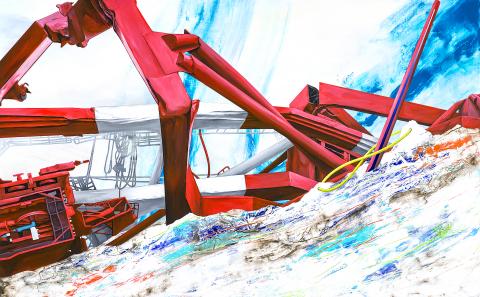
Photo courtesy of Liang Gallery
Trace and Reveal (追尋歷史。原音重現) at the Taiwan Music Institute is a retrospective of Taiwan’s Folk Music Collection Movement from the 1960’s. The movement was organized by a group of musicians, including Hsu Chang-hui (許常惠) and Shih Wei-liang (史惟亮), who saw the need to study and preserve local culture during a time when Taiwanese music was generally overshadowed by the popularity of Western trends. The movement collected over 2,000 recordings of folk music by the Aborigines, Hakka and other Taiwanese. The show features an archive of memorabilia given to the Taiwan Music Institute by Hsu, who kept valuable documentation of their fieldwork, including a set of recordings, field research diaries, hand-written documents, photos and other artifacts from the movement. Since 2000, the institute has been archiving Hsu’s recordings through a process of digitization, transcription and anthropological analysis. Running concurrently with the exhibition is also a program of concerts and talks that take place throughout the show period. Please check with the Taiwan Music Institute for more information.
■ National Traditional Art Center Taiwan Music Institute (國立傳統藝術中心臺灣音樂館), 751, Wenlin Road, Taipei City (台北市文林路751號), tel: (02) 8866-9600. Open Tuesdays to Sundays from 10am to 6pm
■ Until Sept. 30
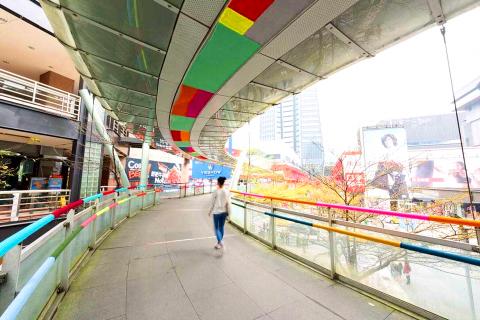
Photo courtesy of Fubon Art Foundation

The canonical shot of an East Asian city is a night skyline studded with towering apartment and office buildings, bright with neon and plastic signage, a landscape of energy and modernity. Another classic image is the same city seen from above, in which identical apartment towers march across the city, spilling out over nearby geography, like stylized soldiers colonizing new territory in a board game. Densely populated dynamic conurbations of money, technological innovation and convenience, it is hard to see the cities of East Asia as what they truly are: necropolises. Why is this? The East Asian development model, with

June 16 to June 22 The following flyer appeared on the streets of Hsinchu on June 12, 1895: “Taipei has already fallen to the Japanese barbarians, who have brought great misery to our land and people. We heard that the Japanese occupiers will tax our gardens, our houses, our bodies, and even our chickens, dogs, cows and pigs. They wear their hair wild, carve their teeth, tattoo their foreheads, wear strange clothes and speak a strange language. How can we be ruled by such people?” Posted by civilian militia leader Wu Tang-hsing (吳湯興), it was a call to arms to retake

This is a deeply unsettling period in Taiwan. Uncertainties are everywhere while everyone waits for a small army of other shoes to drop on nearly every front. During challenging times, interesting political changes can happen, yet all three major political parties are beset with scandals, strife and self-inflicted wounds. As the ruling party, the Democratic Progressive Party (DPP) is held accountable for not only the challenges to the party, but also the nation. Taiwan is geopolitically and economically under threat. Domestically, the administration is under siege by the opposition-controlled legislature and growing discontent with what opponents characterize as arrogant, autocratic

When Lisa, 20, laces into her ultra-high heels for her shift at a strip club in Ukraine’s Kharkiv, she knows that aside from dancing, she will have to comfort traumatized soldiers. Since Russia’s 2022 invasion, exhausted troops are the main clientele of the Flash Dancers club in the center of the northeastern city, just 20 kilometers from Russian forces. For some customers, it provides an “escape” from the war, said Valerya Zavatska — a 25-year-old law graduate who runs the club with her mother, an ex-dancer. But many are not there just for the show. They “want to talk about what hurts,” she